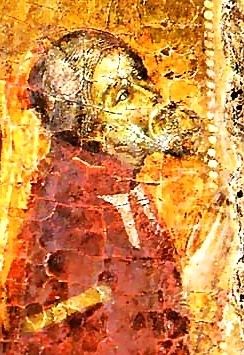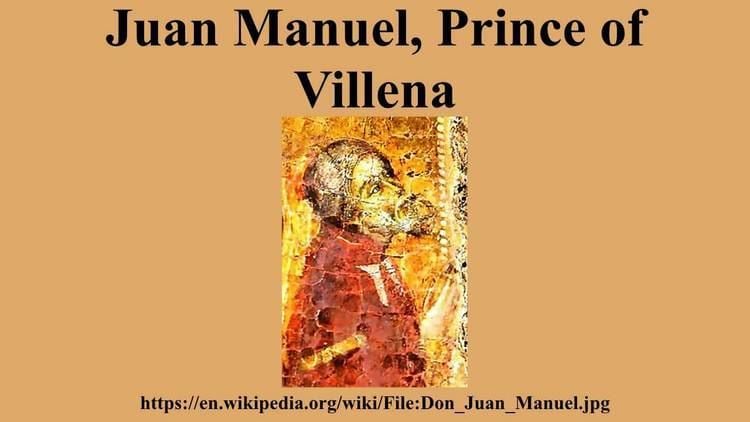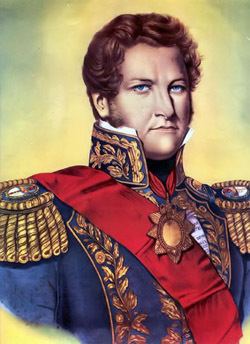Noble family House of Ivrea Role Writer Name Juan Prince | Mother Beatrice of Savoy Father Manuel of Castile | |
 | ||
Born 5 May 1282
Escalona ( 1282-05-05 ) Died June 13, 1348, Penafiel, Spain Spouse Blanca de La Cerda y Lara (m. 1329) Children Juana Manuel, Constanza Manuel Parents Beatrice of Savoy, Lady of Villena, Manuel of Castile Books Tales of Count Lucanor, The Book of Count Lucanor, Count Lucanor: Or - The Fi, Count Lucanor: Or - the Fif Similar People Alfonso X of Castile, Alfonso XI of Castile, Ferdinand III of Castile, Constanza Manuel, Juan Ruiz | ||
Juan manuel prince of villena
Juan Manuel, Prince of Villena (5 May 1282 – 13 June 1348) was a Spanish medieval writer, nephew of Alfonso X of Castile, son of Manuel of Castile and Beatrice of Savoy. He inherited from his father the great Seigneury of Villena, receiving the titles of Lord, Duke and lastly Prince of Villena. He married three times, choosing his wives for political and economic convenience, and worked to match his children with partners associated with royalty. Juan Manuel became one of the richest and most powerful men of his time, coining his own currency as the kings did. During his life, he was criticised for choosing literature as his vocation, an activity thought inferior for a nobleman of such prestige.
Contents

Biography

Juan Manuel was born in the Castle of Escalona, in what is now the province of Toledo. He was a son of Manuel of Castile (son of Ferdinand III of Castile) and his second wife Beatrice of Savoy. His father died in 1284, and Juan was educated at the court of his uncle, Sancho IV, with whom his abilities made him a favourite. With the death of his mother in 1292, Juan Manuel became duke of Peñafiel. Juan Manuel was trained in arts such as equestrianism, hunting, and fencing, and in addition learned Latin, history, law, and theology. At the age of twelve, he fought to repel the attack of the Moors from Granada to Murcia.
In 1304 he was entrusted by the queen mother, Doña María de Molina, to conduct political negotiations with James II of Aragon on behalf of her son, Ferdinand IV, then under age. His diplomacy was successful and his marriage to James II's daughter, Constantina, added to his prestige.
Juan Manuel had constant confrontations with his king. At the time, the throne of Castile was occupied by two monarchs, Ferdinand IV and Alfonso XI. Juan Manuel's loyalty was with Alfonso, to whom Juan Manuel gave the hand of his daughter Constanza. The wedding was postponed several times, until finally Alfonso XI jailed Constanza in the Castle of Toro for unclear reasons. This incident angered Juan Manuel, who decided to turn against Alfonso. He declared war on Alfonso, beginning a long confrontation.
On the death of his wife Constantina in 1327, Don Juan Manuel strengthened his position by marrying Doña Blanca de La Cerda y Lara; he secured the support of Juan Núñez, alférez of Castile, by arranging a marriage between him and Maria, daughter of Don Juan "el Tuerto"; he won over Portugal by promising the hand of his daughter, the ex-queen Constanza, to the infante of that kingdom, and he entered into alliance with Muhammed IV, Sultan of Granada. This formidable coalition compelled Alphonso XI to sue for terms, which he accepted in 1328 without any serious intention of complying with them; but he was compelled to release Doña Constanza. War speedily broke out anew, and lasted till 1331 when Alphonso invited Juan Manuel and Juan Nuñez to a banquet at Villahumbrales with the intention, it was believed, of assassinating them; the plot failed, and Don Juan Manuel joined forces with Peter IV of Aragon. He was besieged by Alphonso at Garci-Nuñez, whence he escaped on 30 July 1336, fled into exile, and kept the rebellion alive till 1338.
Finally, the Pope brought about reconciliation between Juan Manuel and Alfonso XI. This reconciliation was not complete until 1340, when Juan Manuel and Alfonso allied against the Muslims in the Battle of Río Salado, taking the city of Algeciras. After these events, Juan Manuel left political life and retired to Murcia, where he spent his last years focused on literature. Proud of his works, he decided to compile them all in a single volume. This compilation was destroyed in a fire, with no known copy preserved.
Juan Manuel died at Peñafiel in 1348, the age of sixty-six.
Works
Throughout his life, he wrote approximately thirteen books, of which only eight are preserved today. These works are predominantly didactic. Following the path of his uncle, Alfonso X of Castile, Juan Manuel wrote in Castilian, a peculiarity in times when Latin was the official language for educated writing. He wrote in the vernacular to facilitate access to literature for a greater number of Castilian readers.
While his writings were directed largely to a literate class, it was nonetheless his assumption that they would be read aloud, as was common during the Middle Ages. He is ever conscious of propriety, and speaks carefully, both because of his elevated rank, and in case women or children should hear what he has written. His works reflect his character, ambitions, and beliefs, so that in many ways they are a mirror of his time and circumstances.
Juan Manuel's work is marked by a great preoccupation both with the practical and the spiritual life, and is directed not only to the nobility, but also to lower estates, since much of his work speaks not only of the duties of lords, but of their vassals as well. While his work is often classified under the general Medieval rubric of "the education of princes" it also begins to approach the Machiavellianism which is more characteristic of the Renaissance, by virtue of its dedication to the astute art of governing.
Chronological summary
Of Juan Manuel's surviving writings:
Among his lost works, the Libro de los sabios, a treatise called Engeños de Guerra and the Libro de cantares, a collection of verses, were composed between 1320 and 1327; but they have disappeared together with the Libro de la caballeria (written during the winter of 1326), and the Reglas como se debe trovar, a metrical treatise assigned to 1328–1334.
El Conde Lucanor
El Conde Lucanor (the name Lucanor being taken from the prose Tristan), also entitled the Libro de enxemplos, was first printed by Gonzalo Argote de Molina at Seville in 1575, and it revealed Don Juan Manuel as a master in the art of prose composition, and as the predecessor of Boccaccio in the province of romantic narrative. The structure of stories reflects the ordinances and hierarchical structuring of the medieval world. In the first parts a young nobleman, Lucanor, proposes an abstract problem to Patronio; later, he gives an apologue which extracts the solution from Patronio's tale, applying it to himself. Juan Manuel concludes the story with a short verse, condensing the moral of the story into short, concrete statements.
It is essentially the production of a conscious artist, deliberative and selective in his methods. Don Juan Manuel naturalizes the Eastern apologue in Spain, and by the laconic picturesqueness of his expression imports a new quality into Spanish prose which attains its full development in the hands of Juan de Valdés and Cervantes. Some of his themes are utilized for dramatic purposes by Lope de Vega in La Pobreza estimada, by Juan Ruiz de Alarcón in La Prueba de las promesas, by Calderón in La Vida es sueño, and by José de Cañizares in Don Juan de Espina en Milán; there is an evident, though remote, relation between the tale of the mancebo que casó con una mujer muy fuerte y muy brava and The Taming of the Shrew; and a more direct connexion exists between some of Don Juan Manuel's enxemplos and some of Hans Christian Andersen's fairy tales.
Children
His first wife was Elizabeth, daughter of James II of Majorca. She died approximately in 1301 and they had no children.
By Constance of Aragon, daughter of James II of Aragon:
By Blanca de La Cerda y Lara:
Illegitimate by Inés de Castañeda:
Illegitimate by unknown woman:
